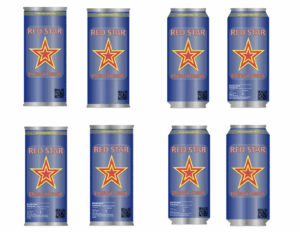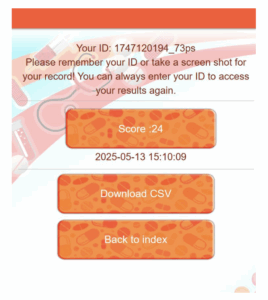Name of the Application: Canned-Beverage Sorting Task (accessible here: http://www.derwinchan.com/Canned-Beverage-Sorting-Task-mobile-devi)
Category of the mobile application: Sport
Platform: Android, iOS, Windows, macOS.
Cost: Free
About the App
Unintentional doping (when athletes inadvertently consume banned substances) remains a significant challenge in sport. The Canned Beverage Sorting Task is a web-based tool that assesses athletes’ ability to identify which beverages are safe to consume without risking anti-doping violations.
The task measures how accurately athletes can identify beverages containing banned substances and whether they avoid products without clear ingredient labels. Initial evidencesuggests that the task is negatively associated with athletes’ implicit doping attitude (Chan et al., 2025), which may relate to doping behavior (Brand et al., 2014; Petróczi et al., 2008).
How it works
The task itself consists of 8 different beverage items: some are safe (do not contain any banned performance-enhancing substances) while others are unsafe (banned performance-enhancing substances are present) canned-beverages (see Figure 1). Each beverage appears four times in a random order, creating in 32 total trials.
Each beverage appears individually and can be examined using the zoom function (pinch-to-zoom for smartphone users, and double clicking/scrolling for computer users).
Figure 1: Canned-beverage sorting task stimuli (8 variations)

Figure 2: Example of the canned-beverage sorting task.

Participants then categorise each beverage as either “can drink” or “cannot drink”based on the ingredients list (see Figure 2). Mobile users can touch the left/right boxes on the screen to respond, whereas computer users can use the arrow keys “←” and “→” on the keyboard. Beverages that contain banned performance-enhancing substances or lack a clear ingredients list should be marked as “cannot drink” (Chan et al., 2015; Chan et al., 2025), while those free from banned performance-enhancing substances should be marked as “can drink”. Instant feedback is provided if the answer is incorrect.
At the end of the task, an automatically generated test result displays the total number of correct responses (see Figure 3) will be presented. Participants can record their participant ID to access their results later and download raw-score data in Excel format (.CSV file) directly.
Figure 3: Example results of the canned-beverage sorting task.

Results and use for clinical practice/research
Previous research examining unintentional doping avoidance used a natural experimental design in which athletes were offered an unfamiliar brand of lollipop (Chan et al., 2015). Building on lollipop protocol, the current canned-beverage task offers a more user-friendly alternative for assessing athletes’ responses when exposed to beverages that may contain banned substances.
As a web-based tool, it requires no actual substance consumption, eliminating the risk of unintentional doping during assessment. This tool effectively simulates real-life decision making and can be administered remotely without face-to-face interaction or specialized computer software. As such, it has strong potential for both clinical and research applications in unintentional doping prevention.
Pros:
- Works on most smartphones (iOS and Android) or computers (Windows, macOS)
- Free of charge with no advertisements
- Does not require installation of software
- Provides bjective assessment of accuracy in avoiding unintentional doping
- Online hypothetical scenario that avoids actual consumption
- Provides instant summary score and raw data for further analysis
Cons:
- Requires internet connection
- Available in English only
- Users should have some basic knowledge about the categories of banned performance-enhancing substances in sport (i.e., steroids)
References
Brand, R., Heck, P., & Ziegler, M. (2014). Illegal performance enhancing drugs and doping in sport: a picture-based brief implicit association test for measuring athletes’ attitudes. Substance Abuse Treatment, Prevention, and Policy,9(1), 7. https://doi.org/10.1186/1747-597X-9-7
Chan, D. K. C., Donovan, R. J., Lentillon-Kaestner, V., Hardcastle, S. J., Dimmock, J. A., Keatley, D. A., & Hagger, M. S. (2015). Young athletes’ awareness and monitoring of anti-doping in daily life: Does motivation matter? Scandinavian Journal of Medicine & Science in Sports, 25(6), e655-e663. https://doi.org/10.1111/sms.12362
Chan, D. K. C., Yip, L. M. H., Tang, T. C. W., Yung, P. S.-H., Gucciardi, D. F., & Hagger, M. S. (2025). Implicit doping attitude and athletes’ accuracy in avoiding unintentional doping when being offered beverages with banned performance-enhancing substances. Journal of Science and Medicine in Sport.https://doi.org/10.1016/j.jsams.2025.04.009
Petróczi, A., Aidman, E. V., & Nepusz, T. (2008). Capturing doping attitudes by self-report declarations and implicit assessment: A methodology study. Substance Abuse Treatment, Prevention, and Policy, 3(9). https://doi.org/10.1186/1747-597X-3-9
The development of this mobile app and the current review are supported by the World Anti-Doping Agency (WADA). The research funding of these projects was awarded to Derwin K. C. Chan in 2017 and 2025. Correspondence concerning this article should be addressed to Derwin K. C. Chan, Faculty of Education and Human Development, The Education University of Hong Kong. Address: 10 Lo Ping Road, The Education University of Hong Kong, Tai Po, New Territories, Hong Kong. Email: derwin@eduhk.hk
Authors:
Tracy C. W. Tang (1)
Patrick Shu-Hang Yung (2)
Daniel F. Gucciardi (4)
Knuckles Ming Fai Cheung (3)
Martin S. Hagger (5, 6)
Derwin King Chung Chan (1,2)
- The Education University of Hong Kong, Hong Kong, China
- The Chinese University of Hong Kong
- App Mocha Limited, Hong Kong, China
- Curtin University, Australia
- University of California, Merced, USA
- University of Jyväskylä, Finland